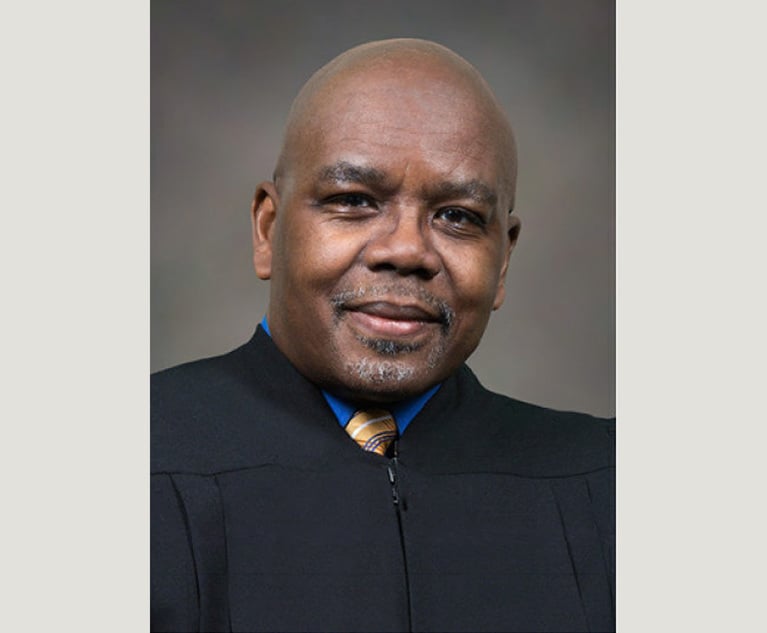With New Trial Tactics Fueling 'Nuclear' Verdicts, Can Defense Catch Up?
The term "nuclear" verdict has a bit of a fluid meaning. Many who spoke with The Legal described it as an award that is significantly higher than would be expected given the injuries in the case, rather than a term indicating any particular threshold.
October 22, 2019 at 05:39 PM
10 minute read
 Photo: Shutterstock
Photo: Shutterstock
Like many defense attorneys across the country, Robert Tyson of Tyson Mendes in San Diego has paid careful attention to the rising tide of so-called "nuclear" verdicts, where juries render awards far beyond what a case would typically be valued at.
When Tyson talks about the outsized awards, and what might be driving them, he sometimes sounds frustrated. That's because he doesn't think the defense bar has been doing enough to counter what many court watchers described as emerging tactics from the plaintiffs bar aimed at getting jurors to "punish" defendants and tether their deliberations on ever higher numbers.
" It's gotten noticeably worse over the past 10 years, but it seems to have picked up pace in the last two," Tyson said. "What has happened is these tactics are now being used by the plaintiffs bar across the country." … The plaintiffs bar is taking the same approach, that the defendants are putting corporate profits over safety. That's their approach and how they're framing the cases. The defense bar's not doing anything differently."
The term "nuclear" verdict has a bit of a fluid meaning. Many who spoke with The Legal described it as an award that is significantly higher than would be expected given the injuries in the case, rather than a term indicating any particular threshold.
According to court watchers, there are numerous reasons why jurors have increasingly awarded high verdicts. One of the key factors is a growing distrust of corporate America, and the pharmaceutical industry in particular, which has seen a recent spate of scandals over issues as widespread as the opioid crisis and as individualized as the Mylan price hikes. Attorneys have also described a sort of "social inflation," where news of one large verdict may lay the groundwork for a jury's understanding of what a reasonable award may be.
However, according to many in the defense bar, plaintiffs attorneys over the past decade have been increasingly turning to trial tactics aimed at getting juries to feel threatened and to use their verdicts to send broader messages. According to some court watchers, the emerging tactics have left the defense bar scrambling to play catch-up.
'Reptile' Brain?
According to many in the defense bar, over the past decade, a growing number of plaintiffs attorneys have been implementing a trial strategy commonly referred to as the "reptile" approach.
It gained prominence through a 2009 book by Don Keenan and David Ball called "Reptile: The 2009 Manual of the Plaintiff's Revolution." The theory underpinning the approach is that attorneys can get jurors to access their "reptile" brain, which, in terms of evolution, is an older part of the brain and is said to control a person's fight or flight response. The idea behind the trial strategy, according to court watchers, is to make jurors feel threatened, so they are more likely to lash out at their perceived attackers.
According to Christina Marinakis, a jury researcher with Litigation Insights, the strategy is meant to put a juror in the shoes of a plaintiff, and to let them know the defendants' alleged conduct could have affected them or anyone in their communities.
"In the 90′s it was all about inducing sympathy. Now it's not about sympathy whatsoever. It's about getting verdicts out of anger," Marinakis said. "They're building up juries to make them feel like they're making a change in the world."
Both Marinakis and Tyson said attorneys often begin the process during voir dire by asking potential jurors whether they would be willing to use their verdict to make a change.
"The No. 1 driver was sympathy. Now it's anger. The plaintiffs bar wants to get the jury angry at the corporate defendants," Tyson said. "It's David versus Goliath."
Some plaintiffs attorneys, however, strongly dispute the characterization that the awards are the result of lawyerly tactics, rather than findings that the facts call for.
"I am not a devotee of any ['reptile'] theory. I am a devotee of bringing the facts to the jury, and when facts are particularly damaging I have a belief that you emphasize those facts and argue those facts," Kline & Specter attorney Thomas Kline said.
Earlier this month, Kline won an $8 billion punitive damages award in a case against Johnson & Johnson over its anti-psychotic drug Risperdal. Much of the arguments in the case centered around facts that, Kline told jurors, showed the company was covering up data linking the medication to a condition causing boys and young men to develop excessive breast tissue.
Regarding that case in particular, Kline noted that 10 jurors had completed college and three had master's degrees, including the fore person, who had a master's in laboratory science, according to Kline. He also noted that, during deliberations, the jury came back with questions about the standard of proof and the definition of "malice" under the law, which, Kline said, showed the jury was clearly methodically deliberating and not acting on base emotions.
Kline suggested that size of the verdicts are proportional to both the severity of the conduct and the size of the defendant company.
"These extraordinary verdicts are the result of extraordinarily bad conduct," Kline said.
McLaughlin & Lauricella attorney Slade McLaughlin, who represents plaintiffs in medical malpractice and catastrophic personal injury cases, said he has used tactics to try to elicit anger from jurors, but added those arguments can't be made in every case, especially when the defendant is a person, rather than a company.
"I don't do it a lot. Jurors, they don't want to dislike people. They want to see the good in people," McLaughlin said. "I do think there's times where it can help, but there are other cases where it's not really all that applicable."
'Anchoring' Damages
Another strategy that's on the rise is referred to as the "anchoring" effort. That phenomenon comes from the notion that juries tend to "anchor" their awards around suggested numbers.
Court watchers gave the hypothetical of a personal injury case where a plaintiff's attorney has asked the jury to award $20 million, and, even though jurors are skeptical about the case, they award $10 million in an effort to split the difference.
"There are social science studies that say jurors will gravitate towards a number, and that can be a fictional number made up by the plaintiffs lawyer," Mark Behrens, co-chair of Shook, Hardy & Bacon's public policy practice, said. "Juries will focus on that number and move it up or down depending on their own feelings."
According to lawyers, attorneys simply asking juries to award large numbers is a big shift over the past decade. Behrens said he also has heard of some trials where the plaintiffs attorney chooses not to introduce any economic damages, and only asks for recovery of noneconomic damages, likely as an effort to ensure jurors don't use the lower number as the anchor.
McLaughlin said there have been instances where he chose not to introduce a plaintiff's wage loss or medicals if the numbers are particularly low.
"I'd much rather argue what I can argue for loss of life's pleasure, or the scarring, or whatever it might be," McLaughlin said.
In Pennsylvania, plaintiffs can't specifically state a number when seeking a damages award, and McLaughlin said he prefers it that way.
"If it's so far out of kilter, then you lose all credibility," McLaughlin said. "I'd rather let them make their own decisions on that."
Fighting Back
Tyson, the San Diego defense attorney, said he is writing a book about new strategies the defense bar can use to counter the plaintiffs bar's emerging tactics, and has been reviewing a lot of closing argument transcripts. He estimated that 99 out of 100 times that a plaintiffs attorney gives a high "anchor" figure to the jury, the defense attorney offers no number in response.
Along those lines, Kline noted that, during the recent Risperdal punitive damages trial, he cited the company's $60 billion net worth, but the defendants never mentioned any lower numbers, such as the company's sales of the drug during the period of time the plaintiff was taking it.
"They had a figure actually on which they could have tried, had they wanted to, to anchor the verdict," Kline said. "There was no argument of any kind to counter."
Tyson said one of his recommendations to the defense bar is that they begin providing counter numbers. Oftentimes defense attorneys, he said, are worried about giving counter numbers for fear that it will seem like they are conceding. However, Tyson said he's been giving juries counter figures, and he's seen success for his clients.
"The jury doesn't even know what is fair and reasonable," he said.
When it comes to combating the reptile strategy, Tyson said he focuses on showing his clients are caring corporate citizens.
"The reality is, all my clients care, none of them set out to make a product to hurt somebody," he said. "They all created something of value, to help. That story's not being told."
According to Marinakis, she has been increasingly advising clients to file motions asking to bar attorneys from using "reptile" theory tactics in an effort to focus on the trial on the immediate case. She also said she advises attorneys to turn the tables and explain to juries about the burden of proof, and how they would not want to be taken to court and forced to disprove something.
Orlando "Rod" Richmond of Butler Snow in Jackson, Mississippi, also said it's important to re-focus the jury on the case in front of it.
"There are jury instructions that address issues of sympathy, there are legal standards which address bias and prejudice, but at the end of the day you want to do your best to maintain your credibility and marshal the facts for the jury," Richmond said.
Plaintiffs attorneys also said they are have started seeing massive barrages of motions in limine in the lead-up to trial, which can often distract the smaller plaintiffs firms from their needed trial prep, but, according to some court watchers, sometimes the oldest strategies are the best ones.
"If you are given a set of facts and circumstances that contains that ignition, such that liability and fear and anger would result … settle the case," said defense attorney Jeffrey O'Hara of Connell Foley. "Lawyers aren't magicians. The most talented lawyers in the country cannot change the facts. If the facts related to liability are that concerning, it begs the question, why would you defend that theory in the first place?"
This content has been archived. It is available through our partners, LexisNexis® and Bloomberg Law.
To view this content, please continue to their sites.
Not a Lexis Subscriber?
Subscribe Now
Not a Bloomberg Law Subscriber?
Subscribe Now
NOT FOR REPRINT
© 2025 ALM Global, LLC, All Rights Reserved. Request academic re-use from www.copyright.com. All other uses, submit a request to [email protected]. For more information visit Asset & Logo Licensing.
You Might Like
View All
'Discordant Dots': Why Phila. Zantac Judge Rejected Bid for His Recusal
3 minute read
Pittsburgh Jury Tries to Award $22M Against J&J in Talc Case Despite Handing Up Defense Verdict
4 minute read
Plaintiffs Seek Redo of First Trial Over Medical Device Plant's Emissions
4 minute read
Trending Stories
- 1Silk Road Founder Ross Ulbricht Has New York Sentence Pardoned by Trump
- 2Settlement Allows Spouses of U.S. Citizens to Reopen Removal Proceedings
- 3CFPB Resolves Flurry of Enforcement Actions in Biden's Final Week
- 4Judge Orders SoCal Edison to Preserve Evidence Relating to Los Angeles Wildfires
- 5Legal Community Luminaries Honored at New York State Bar Association’s Annual Meeting
Who Got The Work
J. Brugh Lower of Gibbons has entered an appearance for industrial equipment supplier Devco Corporation in a pending trademark infringement lawsuit. The suit, accusing the defendant of selling knock-off Graco products, was filed Dec. 18 in New Jersey District Court by Rivkin Radler on behalf of Graco Inc. and Graco Minnesota. The case, assigned to U.S. District Judge Zahid N. Quraishi, is 3:24-cv-11294, Graco Inc. et al v. Devco Corporation.
Who Got The Work
Rebecca Maller-Stein and Kent A. Yalowitz of Arnold & Porter Kaye Scholer have entered their appearances for Hanaco Venture Capital and its executives, Lior Prosor and David Frankel, in a pending securities lawsuit. The action, filed on Dec. 24 in New York Southern District Court by Zell, Aron & Co. on behalf of Goldeneye Advisors, accuses the defendants of negligently and fraudulently managing the plaintiff's $1 million investment. The case, assigned to U.S. District Judge Vernon S. Broderick, is 1:24-cv-09918, Goldeneye Advisors, LLC v. Hanaco Venture Capital, Ltd. et al.
Who Got The Work
Attorneys from A&O Shearman has stepped in as defense counsel for Toronto-Dominion Bank and other defendants in a pending securities class action. The suit, filed Dec. 11 in New York Southern District Court by Bleichmar Fonti & Auld, accuses the defendants of concealing the bank's 'pervasive' deficiencies in regards to its compliance with the Bank Secrecy Act and the quality of its anti-money laundering controls. The case, assigned to U.S. District Judge Arun Subramanian, is 1:24-cv-09445, Gonzalez v. The Toronto-Dominion Bank et al.
Who Got The Work
Crown Castle International, a Pennsylvania company providing shared communications infrastructure, has turned to Luke D. Wolf of Gordon Rees Scully Mansukhani to fend off a pending breach-of-contract lawsuit. The court action, filed Nov. 25 in Michigan Eastern District Court by Hooper Hathaway PC on behalf of The Town Residences LLC, accuses Crown Castle of failing to transfer approximately $30,000 in utility payments from T-Mobile in breach of a roof-top lease and assignment agreement. The case, assigned to U.S. District Judge Susan K. Declercq, is 2:24-cv-13131, The Town Residences LLC v. T-Mobile US, Inc. et al.
Who Got The Work
Wilfred P. Coronato and Daniel M. Schwartz of McCarter & English have stepped in as defense counsel to Electrolux Home Products Inc. in a pending product liability lawsuit. The court action, filed Nov. 26 in New York Eastern District Court by Poulos Lopiccolo PC and Nagel Rice LLP on behalf of David Stern, alleges that the defendant's refrigerators’ drawers and shelving repeatedly break and fall apart within months after purchase. The case, assigned to U.S. District Judge Joan M. Azrack, is 2:24-cv-08204, Stern v. Electrolux Home Products, Inc.
Featured Firms
Law Offices of Gary Martin Hays & Associates, P.C.
(470) 294-1674
Law Offices of Mark E. Salomone
(857) 444-6468
Smith & Hassler
(713) 739-1250





